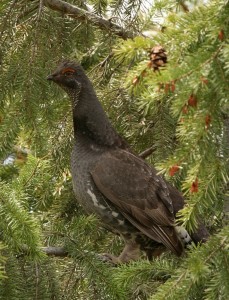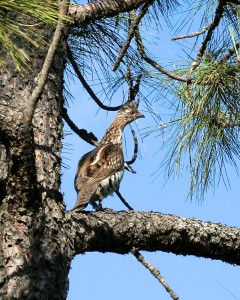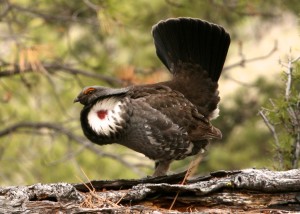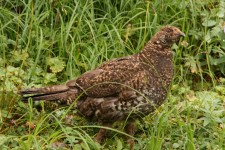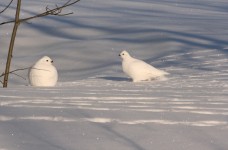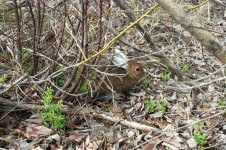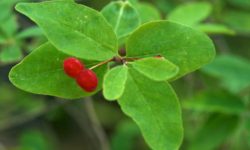When a grouse flushes from the brush, my heart skips a beat before I scan to see who made the noise. Was it a spruce grouse, ruffed grouse or dusky grouse? Each of the three species living in North Idaho has certain characteristics that help with identification.
If the grouse is big, it most likely is a dusky grouse. Dusky grouse are twice the size of ruffed grouse which are roughly one pound. The spruce grouse is the smallest of the three species.
Just in case you are wondering, dusky grouse were once called blue grouse. In 2006, the American Ornithologists Union decided to split blue grouse into two species– dusky grouse and sooty grouse–based on genetic, morphological and behavioral differences. Basically, blue grouse living west of the Cascade crest are sooty grouse and those living east are dusky grouse.
One difference between dusky grouse and sooty grouse is the color of the air sacs visible during the male’s display. Dusky grouse have red air sacs and sooty grouse have yellow air sacs, a distinguishing feature from spruce and ruffed grouse.
Male spruce grouse have the identifiable red comb above the eyes with white arcs under the eyes. Dusky grouse also have a comb but it is yellow-orange.
Ruffed grouse have the noticeable short, triangular crest on their head but they are actually named for the rich black ruff of neck feathers the male exposes during displays.
If you happen upon a grouse before it flushes, color can help distinguish them. Spruce grouse have golden flecks in their otherwise dark plumage with white speckling on their lower chest and belly.
Ruffed grouse have a light or reddish background color compared to the dark grayish brown of the dusky grouse. Ruffed grouse are also known for their intricately patterned plumage of dark bars and spots.
If the grouse presents the opportunity, take a look at its tail. The ruffed grouse has a pale tail with a dark band near the tip. A spruce grouse has an all black tail sometimes with a rufous tip. Dusky grouse also have a solid, dull black tail but with a gray tip.
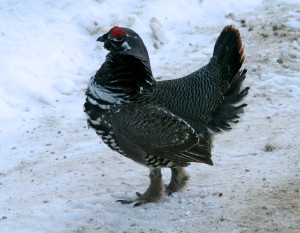
A red comb above the eye and white speckling on the lower chest and belly help identify a male spruce grouse
Sometimes grouse don’t present a good opportunity to study their features so a look at their habitat might help.
Ruffed grouse prefer to live in thick mixed forests of pine, aspen and other deciduous trees. They eat a variety of leaves, berries, twigs, buds and catkins.
Dusky grouse reside in open forests of mixed conifers and deciduous trees to forage on leaves, flowers, buds, berries and insects. They are most commonly seen in true fir and Douglas-fir forests in the winter and more open habitats in the summer. In the winter they move up into the mountains to conifer stands where there is less competition for food, which consists of needles and buds of pine, fir and spruce trees.
Also at high elevations, but year-round, are spruce grouse. They live in conifer forests mainly consisting of spruce and fir trees or moist habitats with lodgepole pine. Unlike dusky grouse, they forage year-round on pine, spruce and fir needles.
And if you can’t see the grouse, you might hear the males in the spring. Ruffed grouse are well known for their drumming courtship displays which consist of beating their wings about 50 times in eight to 11 seconds with increasing speed. Whereas the spruce grouse only makes one or two loud claps with its wings.
Dusky grouse perform hooting displaying consisting of five to seven low frequency hoots while in their breeding territory and a single “whoot” when displaying for a female.
Between the displays and the plumage, the males of each species are easier to distinguish than the females. However, you need to recover from the startle quick enough to catch a glimpse of any of them.

